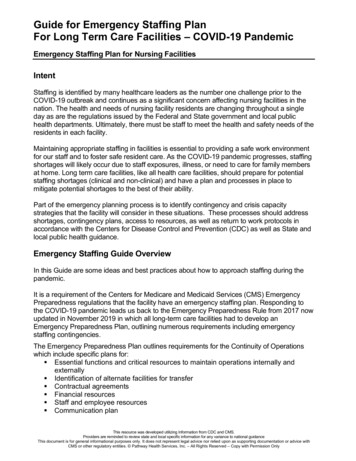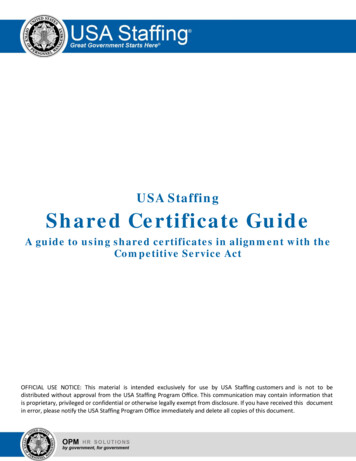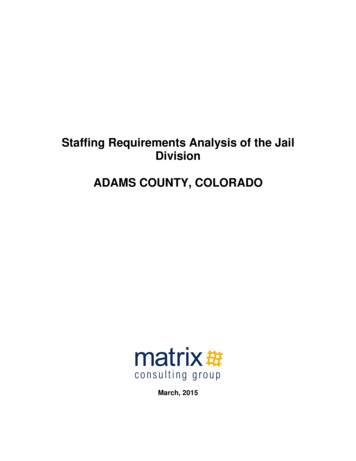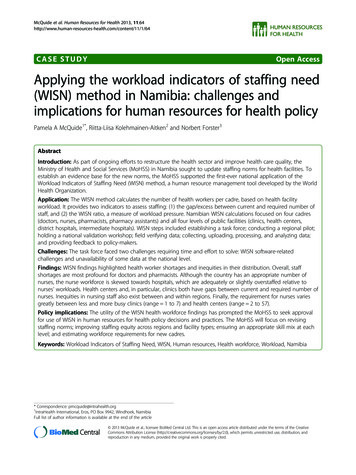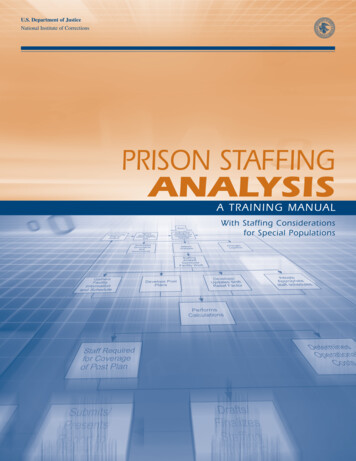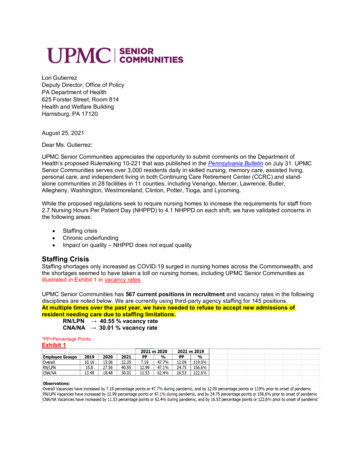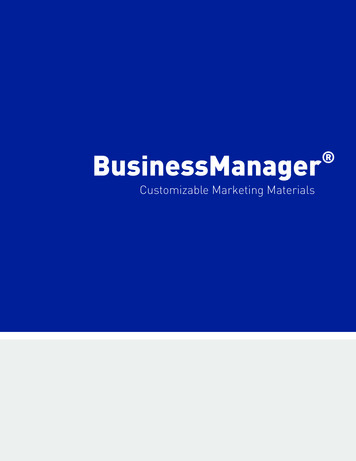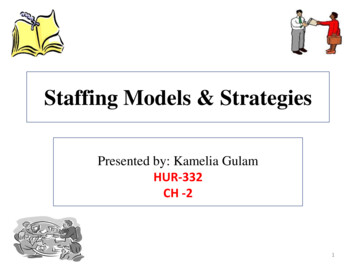
Transcription
Staffing Models & StrategiesPresented by: Kamelia GulamHUR-332CH -21
Staffing Organizations Model
Outline Nature of Staffing The Big Picture Definition of StaffingImplications of DefinitionStaffing System Examples Staffing Models Staffing Quantity: Levels Staffing Quality: Person/JobMatchStaffing Quality:Person/Organization Match Staffing Models– Staffing SystemComponents– Staffing Organizations Staffing Strategy– Staffing Levels– Staffing Quality Staffing Ethics3
Learning Objectives for This Chapter Define staffing and consider how, in the big picture, staffingdecisions matter Review the five staffing models presented, and consider theadvantages and disadvantages of each Consider the staffing system components and how they fitinto the plan for the book Understand the staffing organizations model and how itsvarious components fit into the plan for the book Appreciate the importance of staffing strategy, and review the13 decisions that staffing strategy requires Realize the importance of ethics in staffing, and learn howethical staffing practice is established1-4
Discussion Questions for This Chapter What would be the potential problems with a staffing processin which vacancies were filled:– On a lottery basis from among job applicants?– On a first come-first hired basis? What would be the advantages of using one of the aboveprocesses? Would it be desirable to hire people only according to theperson/job match, ignoring the person/organization match?Why? How are staffing activities influenced by training orcompensation activities? Are some of the 13 strategic staffing decisions moreimportant than others? Which ones? Why?1-5
The Big Picture Organizations are combinations of physical,financial, and human capital Human capital– Knowledge, skills and abilities of people– Their motivation to do the job Scope of human capital– An average organization’s employee cost (wages orsalaries and benefits) is over 25% of its total revenue– Organizations that capitalize on human capital have astrategic advantage over their competitors6
Nature of Staffing Definition– “ Staffing is the process of acquiring, deploying,and retaining, a workforce of sufficient quantityand quality to create positive impacts on theorganization’s effectiveness” Implications of definition– Acquire, deploy, retain– Staffing as a process or system– Quantity and quality issues– Organization effectiveness1-7
Implications of definition Implications of definition Acquire, deploy, retainAcquisition: activities involve external staffing system that governthe initial of applicants into the organization.Deployment: the movement of current employees throughout theorganization through internal staffing that handle promotions,transfers, and new project assignments.Retention: organization should try to minimize the turnover andretain the valued employees.8
Implications of definition (Continued) Staffing as a process or systemOrganization use multiple interconnected system to manage thepeople flows. These include planning, recruitment, selection,decision making, job offer, and retention system. Quantity and qualityStaffing the organization requires attention to both the number(quantity) and the type (quality) of people brought into, movedwithin, and retained by the organization. Organization effectivenessStaffing systems should be used to contribute to achievement oforganization goals and attaining organization growth.9
Organizational structure An organization is a combination of:– Physical, Financial & Human Capital Human Capital refers to:– Knowledge, skills, and ability of its people! Workforce Quality Stock of human capital thatit– Acquires, deploys, and retains in pursuit ofOrganizational Profitability, market share, customer satisfaction andenvironmental stability1-10
Staffing Organizations function used to build yourworkforce! How? Thru a System called Staffing Strategythat includes:– HR Planning– Recruiting– Selection– Employment– Retention11
Staffing (Continued) Labor is the single most significant cost of doingbusiness: payroll and replacement costs.– (With this, we must begin with hiring the right peopleand then developing them effectively) Business strategies require specific skills andbehaviors to be successful. Employees provide customer service, create value, andexecute strategy. HR practices can be crafted to support certain types of skillsand encourage behaviors. “How do we hire the right people?”12
Staffing (Continued) Staffing is an important managerial function. Staffing is a pervasive activity. Staffing is a continuous activity. The basis of staffing function is efficient managementof personnel. Staffing helps in placing right men at the right job. Staffing is performed by all managers .13
Staffing (Continued) Business strategies require specific skills andbehaviors to be successful. Employees provide customer service, create value, andexecute strategy. HR practices can be crafted to support certain types of skillsand encourage behaviors. “How do we ensure we are hiring the rightpeople?” Using Updated Job Descriptions – Competency based Then ---What is our Staffing Objective?
Staffing (Continued) What is our Staffing Objective?– To find more productive ways to do work! Increased productivityFlexible workforceMulti-skilled workforceMulti-skilled job descriptions Can “good” staffing lead to better organizationaleffectiveness?– Yes, strongly supported by research findings15
Staffing System Examples W.L. Gore and Associates– Staffing jobs without titles– Focus on culture in recruiting and selecting Pfizer Pharmaceuticals– Hiring for flexibility in a rapidly changing market– Focus on hiring individuals who can change rolesquickly Enterprise Rent-A-Car– Use a strong internal labor market– Performance evaluation is used for placement1-16
Discussion Questions Whatwould be the potential problems witha staffing process in which vacancies werefilled:On a lottery basis from among job applicants? On a first come-first hired basis? Whatwould be the advantages of usingone of the staffing processes?17
Importance to Organizational Effectiveness Quotes from organization leaders– Staffing is absolutely critical to the success of every company Gail Hyland-Savage, COO, Michaelson, Connor, & Bowl– At most companies, people spend 2% of their time recruitingand 75% managing their recruiting mistakes. Richard Fairbank, CE, Capital One– I think about this in hiring, because our business all comes downto people In fact, when I’m interviewing a senior job candidate,my biggest worry is how good they are at hiring. I spend at leasthalf the interview on that. Jeff Bezos, CEO, Amazon– We missed a really nice nursing rebound because we didn’t doa good job hiring in front of it. Nothing has cost the business asmuch as failing to intersect the right people at the right time. David Alexander, President, Soliant Health1-18
Discussion Questions Whatwould be the potential problems witha staffing process in which vacancies werefilled:On a lottery basis from among job applicants? On a first come-first hired basis? Whatwould be the advantages of usingone of the staffing processes?19
Discussion Questions Whatwould be the potential problems witha staffing process in which vacancies werefilled:On a lottery basis from among job applicants? On a first come-first hired basis? Whatwould be the advantages of usingone of the staffing processes?20
Staffing Models Staffing Quantity LevelsStaffing QualityPerson/Job Match Person/Organization Match Staffing System Components Staffing Organizations 21
1- Staffing QuantityStaffing QuantityStaffing countingConsidering quantity but not qualityThe simplest model22
1- Staffing Quantity Levels The organization as a whole, as well aseach of its units, forecasts workforcequantity requirements and then comparesthese forecasted with workforceavailabilities to determine the staffing levelposition.23
Staffing Quantity Levels Cont Staffing level positionsFully staffed : Head count requirement workforce availableUnder Staffed: Head count requirement workforce availableOver Staffed: Head count requirement workforce available24
2- Staffing QualityPerson/Job MatchKnowledge, Skills, Abilities, and Other characteristics25
2-Staffing QualityPerson/Job Match Jobs are characterized by their requirementsand rewards. Individuals are characterized via qualifications(KSA’S) and motivation. There is a need for match between the personand the job It will have positive impact on HR outcomes(employee satisfaction, retention, jobperformance)26
“How do we hire the right people?”– Traditionally staffing has focused on the matchbetween an applicants skills and experience andthe job ��sMotivation
Person/Job MatchJobHR ationImpactPerformanceExtra EffortRetentionSatisfactionCommitment
Concepts: Person/Job Match Model Jobs are characterized by theirrequirements and rewards Individuals are characterized viaqualifications (KSAOS) andmotivation These concepts are not new orfaddish, this is an enduring modelof staffing Matching process involves dualmatch– KSAOs to requirements– Motivation to rewards Job requirements expressed interms of both Tasks involved KSAOs necessary forperformance of tasks Job requirements often extendbeyond task and KSAOrequirements1-29
Person/Organization MatchTask FlexibilityJobRequirementsRewardsCareer rsonKSA’s / MotivationATTITUDEHR OutcomesPerformanceExtra EffortRetentionSatisfactionCommitment
Person/Organization Match1-31
Concepts: Person/OrganizationMatch Model Organizational culture and values– Norms of desirable attitudes and behaviors for employeesFor example: honest, achievement, hard work. New job duties– Tasks that may be added to target job over time– “And other duties as assigned . . . “ Multiple jobs– Flexibility concerns - Hiring peoplewho could perform multiple jobs Future jobs– Long-term matches during employment relationship– organization would like to hire people could perform thesenew duties without having to hire additional employees.1-32
Human Resource ManagementEmployeeRelations/EqualEmploymentRisk ManagementCompensationTotal CompensationPerformanceManagementPlanning - StrategicManagementRecruiting andSelection/StaffingTraining andDevelopment –TalentManagement
Staffing and StrategyEmployeeRelationsPerformance requires HR practices that: Match the business strategy Are internally consistent Fit with organizational values and beliefsPlanningandJob RecruitingandSelectionTraining andDevelopment
Discussion Questions Would it be desirable to hire people onlyaccording to the person/job match, ignoringthe person/organization match? Why? How are staffing activities influenced bytraining or compensation activities?35
Staffing System Components36
Staffing System ComponentsStaffing begins with a join interactionbetween the applicant and theorganization37
Staffing System Components The initial stage in staffing is recruitment. Theorganization seek to attract applicant and theapplicant try to find organization with jobopportunities.38
Staffing System Components In the selection stage the emphasis is onassessment and evaluation. The organizationwill assess the applicant KSA,s and motivation.Also the applicant is assessing and evaluatingthe job and the organization to determine thedegree of person job match.39
Staffing System Components The last core of component of staffing isemployment which involves decision makingand final match activities by the organizationand applicant. The organization must decidedto whom it will make the job offer, what thecontent of the job offer will be, and how it willdrawn up to the applicant.
Staffing Organizations Model The organization mission and its goals andobjectives drive both organization strategy andHR and staffing strategy. organization strategy and HR and staffing strategyinteract with each other when they are beingformulated, staffing policies and programs resultfrom that interaction, and they serve as anoverlay to both support activities and corestaffing activities. Employee retention and staffing systemmanagement concern cut across support andcore staffing activities.41
Staffing Organizations Model Cont.–Strategic Human ResourceManagement Organizational Strategy HR (Staffing) strategy Staffing becomes part of the overall organization strategy Core staffing activities are carefully “regulated” to match theorganization strategy42
Components of StaffingOrganizations Model Organizational strategy– Mission and vision– Goals and objectives HR strategy– Involves key decisions about sizeand type of workforce to be AcquiredTrainedManagedRewardedRetained– May flow from organizational strategy– May directly influence formulation of organization strategy1-43
Components of StaffingOrganizations Model (continued) Staffing strategy– An outgrowth of the interplay between organization and HR strategy– Involves key decisions regarding acquisition, deployment, andretention of organization’s workforce Guide development of recruitment, selection, and employment programs Support activities– Serve as foundation for conduct of core staffing activities Core staffing activities– Focus on recruitment, selection, and employment of workforce Staffing and retention system management1-44
What is Staffing Strategy? Definition– Requires making key decisions about acquisition,deployment, and retention of a company’sworkforce Involves making 13 key decisions Decisions focus on two areas– Staffing levels– Staffing quality1-45
Strategic Staffing Decisions Staffing Levels–––––––––Acquire or Develop TalentHire Yourself or OutsourceExternal or Internal HiringCore or Flexible WorkforceHire or RetainNational or GlobalAttract or RelocateOverstaff or UnderstaffShort- or Long-term Focus Staffing Quality– Person/Job orPerson/Organization match– Specific or general KSAOs(Knowledge, Skills, Abilities,and Other characteristics)– Exceptional or acceptableworkforce quality– Active or passive diversity1-46
Suggestions for Ethical Staffing Practice Represent the organization’s interests.Beware of conflicts of interest.Remember the job applicant.Follow staffing policies and procedures.Know and follow the law.Consult professional codes of conduct.Shape effective practice with research results.Seek ethics advice.Be aware of an organization’s ethical climate/culture1-47
Performance Management Performance management systems– Timing, forms, and outcomes– Managing for employee motivation Goal setting Pay for performance Providing performance feedback
Discussion Question Are some of the 13 strategic staffing decisionsmore important than others? Which ones?Why?1-49
Staffing System Components The last core of component of staffing isemployment which involves decision makingand final match activities by the organizationand applicant. The organization must decidedto whom it will make the job offer, what thecontent of the job offer will be, and how it willdrawn up to the applicant.50
ethical staffing practice is established Learning Objectives for This Chapter. 1-5 What would be the potential problems with a staffing process . The basis of staffing function is efficient management of personnel. Staffing helps in placing right men at the right job. Staffing is performed by all managers . 13

